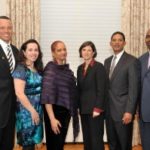In the past, cultural activities gave young APAs the rare opportunity to interact with other Asians, but with today’s burgeoning ethnic enclaves, do language schools and Asian sports leagues foster an ethnocentric attitude?By LYNDA LIN, Assistant Editor, Pacific Citizen
From kindergarten until she entered high school, Christina Li would leave her “American” high school at 3 p.m. and take a bus to a local Chinese school where she spent two hours perfecting the cadences of her native language. One extra hour was devoted to mastering the brush strokes of Chinese calligraphy, a traditional art form lost to most young Asian Pacific Americans who prefer to scrawl with pens and computer keyboards. Christina, now 18 and attending Harvard University, chose to practice Chinese calligraphy over other cultural activities because she enjoyed the structure of the art form. And although Christina’s after school class was a scheduling convenience for her working mother Peggy Li, it was also hoped that Christina would forever etch her cultural identity into her life with every brush stroke. Because in the Li family, being Chinese is a lifestyle. And for many other APA families separated from their native soil, cultural activities act as bridge between two nationalities to create a harmony where cultural heroes like Momotaro (the Japanese folklore hero also known as “Peach Boy”) aren’t completely taken over by the likes of SpongeBob SquarePants or Harry Potter. “It’s important to infuse children with cultural activities because it’s their root,” said Peggy. “You may not realize it when you’re young, but you’ll know when you’re older how important it is…” Peggy, who immigrated to the United States from China in 1979 to complete her graduate studies at the California Institute of Technology, is part of a growing number of APA parents who want to keep their American offspring firmly rooted in their heritage. At times, this means having to pack schedules with culturally specific activities including Asian language school, dance and Asian league sports to keep younger generations tied to the old world. But as the APA population continues to grow, according to Census statistics, and ethnic enclaves persist, what evolving role does cultural activities play in the communities?
Speaking Your Ancestors’ LanguageThe Li family live in the suburban city of Arcadia, Calif. where, according to the 2000 Census, APAs composed 45.4 percent of the population. For students like Christina, this meant spending the day at an APA populous high school and than spending more time at an APA dominated language school. But Christina did not mind the extra schooling because most of her friends did the same. “It felt normal to go to Chinese school,” she said. At the age of eight, Los Angeles resident Peter Khauo and his two siblings were also enrolled in Chinese school — a non-negotiable rite of passage. Peter’s parents emigrated from Thailand to settle in East Los Angeles and Chinese language school was a way to keep their children from becoming “so Americanized.” At home, questions asked in English would have to be translated into Chinese in order to merit an answer. “They said, ‘When you’re at home, you speak Chinese,’” said Khauo, now a 24-year-old photographer. The Khauo family was also active in their local Buddhist church, and once a year Peter would put on “old school” Chinese costumes and march in the Chinese New Year parade carrying ornate Chinese flags. It’s a definite trend for first generation immigrant parents to raise their children with ethnic-specific activities, said Ruth Chao, a professor of psychology at the University of California, Riverside who researches the socialization of Asian immigrant families. Although there are many variations to the trend, Chao said studies have revealed that cultural activities are beneficial in fostering bi-cultural identities by helping young APAs acculturate to mainstream society while keeping them tuned into their heritage at the same time. An adolescent who chooses to use the native language with his or her parents is honoring them and respecting them, added Chao. Jane Chen, principal of the San Jose based Mandarin Language and Cultural Center, said she has seen an increasing interest in learning Mandarin. Her school sees about 1,100 students per year who learn language, calligraphy, dance and even flower arrangement. But whereas in the past these cultural activities gave young APAs the rare opportunity to be amongst other Asians, in modern day ethnic communities like California’s San Gabriel Valley, these activities have turned into occasions to give young adults more of the same. For some, their worlds have become a fish bowl. “There have been studies relating to kids who grew up in mostly Asian communities going off to private and prestigious colleges in the Northeast and really struggling because they don’t have the experience … and the racism and discrimination really hits them hard,” said Chao. “They really struggle.” For the most part, Christina isn’t too worried about adjusting to life at Harvard, which only has a 12 percent Asian student population, but she admits it’s going to be different. “I tend to be more comfortable around Asians. Most of my friends now are Asian because of the similar culture. We can communicate better with that sort of background where what’s important to our parents is important to us,” she said.
The Culture in SportsLike many other cultural activities, the Community Youth Council (CYC) sports league originated in the 1950s to give boys of Japanese ancestry the chance to play in competitive sports regardless of their skill level, but it also served an important socialization purpose. When Bobby Umemoto first expressed interest in playing sports, his parents nudged him towards the CYC Japanese American sports league. “I think part of it is that you can be with others from the Japanese community. If it weren’t for the [CYC sports], there weren’t a lot of Japanese people around,” said Umemoto, 54, about growing up in the city of Los Angeles. “In the Japanese league, it’s recreational … it’s about getting together, having fun and playing a little ball.” Bobby played baseball and basketball in the CYC leagues and at his high school and at the collegiate level. Now without the “fire” he once had in his youth, he organizes and coaches in the adult league, the Nisei Athletic Union (NAU). Through the years, he’s noticed an evolution in JA league sports. These days, he said the Los Angeles CYC teams are flushed with kids who trek from ethnic enclaves like the San Gabriel Valley to play in Asian league sports. For some, this creates a false sense of superiority. “This kid might be your superstar [in the CYC league] and you treat him as a prima donna. Then he goes to high school and he’s not used to being instructed harshly or not starting. Those are realities,” said Bobby, whose four sons, affectionately known as “Bobby Boys,” play sports but not all went through the CYC circuit. But for others, the Asian sports leagues are still crucial cultural bridges. Jesse James, who was born in Japan, said he learned to become more accepted in the JA community by playing sports. Now, his son who attends a predominately White school in Orange County, Calif. enjoys similar benefits by playing in the local JA sports league. Every August, the leagues’ teams participate in the Nikkei Games, an Olympic style competition that James directs.
“It’s about making kids feel good about themselves,” said James, 54, about the league which mixes sports with cultural activities like mochi making. “The fact is that unless you go to an all JA or an all Asian school, you’re not around a lot of Asians, so hanging out on weekends with JAs is good,” he said. “Are they engulfing themselves in too much of the same? Absolutely not.” For Vince Hamasaki, the need for Asian league sports became all too clear when he and his family moved to a mostly White community, so when it came time to choose a sports program for his kids, he and his wife decided that “going the Asian route was a good way to go.” He sees both social and cultural positives in Asian league sports. His sons Jordan and Taylor make friends in school and different friends with Asian teammates on the weekend. “I see it as the best of both worlds,” said Vince. “For me living out here, it’s a positive.” “I think it’s important to at least maintain our Asian friends as well as maintain culture,” he added. But perhaps more important is the fact that recent graduates of cultural school and sports say they would continue the tradition. “I think I will send [my kids] to Chinese school. It’s not negotiable,” said Christina.
|
||
|











